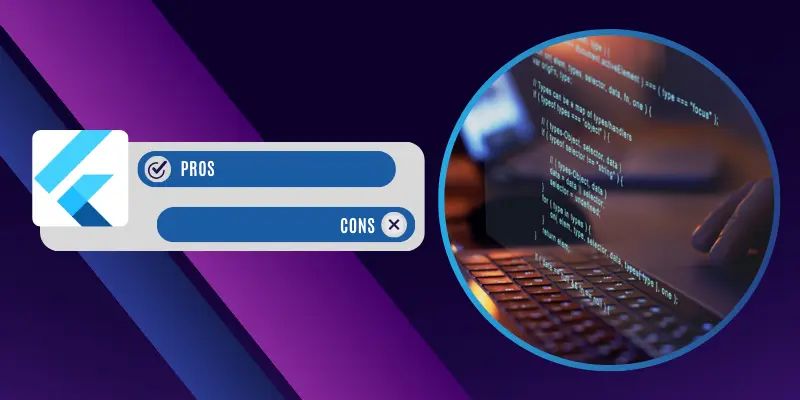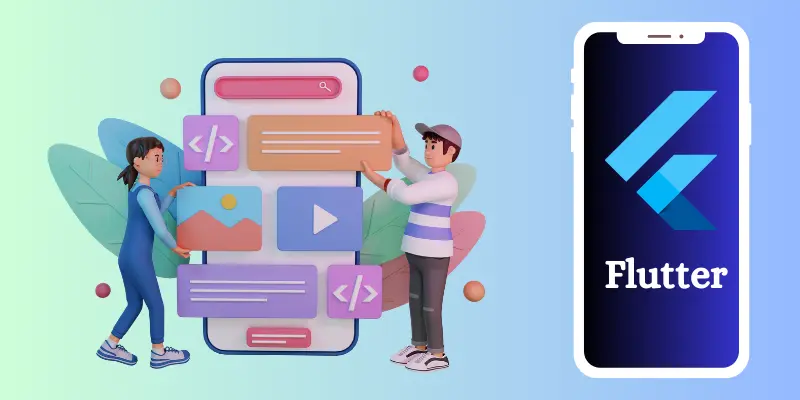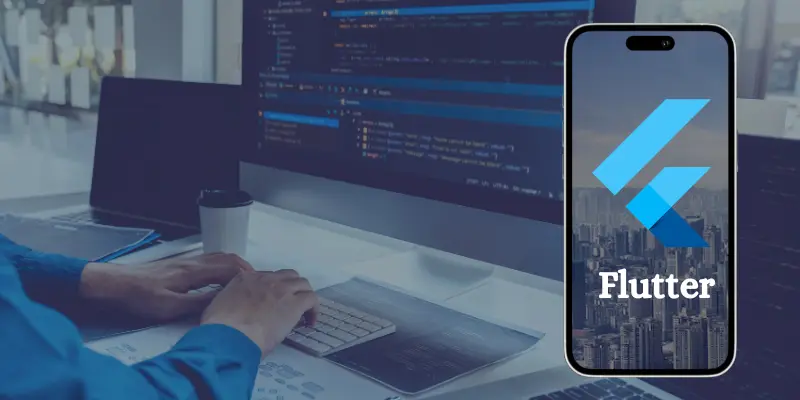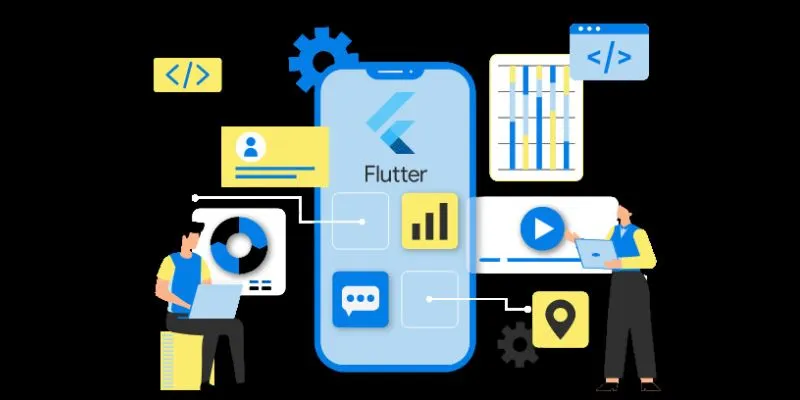Selecting the right tech stack to develop your app project is a crucial option you must make in conjunction with the development team in the early stages of planning. Flutter is the most used framework for developing cross-platform mobile apps. Apart from the time and energy-saving benefits of Cross-Platform App Development compared to native app development, Flutter has many advantages that improve the development process.
Flutter permits you to develop applications that run on multiple platforms and provide native performances. Applications created using Flutter have a beautiful and accessible style and can seamlessly run animations. Flutter can also boost the speed of mobile development, which helps reduce the development cost.
However, is it the best choice for your venture, and what risks should you know? In this post, we'll examine Flutter's advantages and disadvantages and show why it is one of your needs.
What Is Flutter?
Flutter is a cross-platform application development framework that is built on Dart. Dart programming language. It focuses on developing desktop, mobile, and apps with the same source code, offering user-friendly, fast beauty and user interfaces. Dart is an object-oriented programming language that uses a C-like syntax. It is mainly utilized for Front-End Development. Developers of Flutter do not have to write separate programs to create the iOS app and then write separate codes to make the Android solution. You only need to develop an entire code base further designed to run on various operating systems -not just Android and iOS but macOS, Linux, Windows, and others.
Flutter comprises two main components: the software development kit, which comes with tools to convert codes to native machine language, and integrated testing tools. Flutter supports the development of mobile apps for Android and iOS with a single codebase and desktop platforms and websites.
What's So Unique About Flutter?
Flutter is different from other frameworks in various ways. In particular, it uses an object-oriented Dart programming language. React Native uses JavaScript, while Cordova utilizes HTML, CSS, and JavaScript. Flutter is a native-code compiling language that allows direct access to device components for improved efficiency and faster rendering compared with React Native's bridge-based communications.
Flutter lets you customize a wide range of UI widgets, while React Native and Cordova may limit the customization of native components. Due to the hot reload feature, Flutter offers a quicker development process than React Native. Cordova requires more time to build and test apps than the two frameworks. Overall, Flutter is a potent and flexible software development tool that offers numerous benefits over other frameworks, such as vast UI flexibility, customization, and speedier development. Although React Native and Cordova are very popular, they're getting beaten out by Flutter.
Pros Of Development With Flutter
To reap Flutter's most significant advantages, you must ensure that your team of developers is skilled and experienced in using this technology to suit your business's requirements best.
Faster Time-To-Market
One of the most significant benefits of choosing Flutter App Development is the capability to dramatically speed up the time to market. With an array of functions that help you with the creation process, Flutter empowers you to launch your application to the market quickly. Also, the latest features and upgrades for iOS and Android platforms will be released simultaneously.
The efficacy of Flutter's codebase unification across different platforms is crucial in speeding up the time-to-market journey. In contrast to the traditional approach, which needs separate codebases to support Android or iOS, Flutter leverages one codebase that can be used for each platform. The harmonious integration of code speeds up the development process because it eliminates the necessity for multiple coding projects. This allows developers to concentrate on improving the functionality of their app instead of juggling the specific platform's issues.
Efficient Development Process
As a cross-platform platform, Flutter allows you to create an application that works on both platforms with the same codebase. However, that's not the only reason Flutter helps make development quicker and more effective. The application also supports hot restart and the renowned "hot reload" function, which lets you see changes in real-time without restarting the application. This dramatically speeds up development. React Native and Xamarin share identical functions, yet they're slower. Thanks to these capabilities, Flutter allows you to conserve time and money.
Lower Development Costs
This benefit is closely related to the first. It's cheaper to Create a Mobile App with just one code base and later use it in multiple app versions.
Native-Like Experience
Flutter doesn't employ intermediary interpreters or code representations, which can negatively impact the software's performance. Instead, it uses a graphics engine, which ensures seamless, native-like performance for multi-platform apps.
Single Code For Different Operating Platforms
Developers of Flutter need to create code once before using it in developing mobile, web, and desktop applications.
Utilization Of Widgets
Within the Flutter Framework, the widgets comprise the core class hierarchy and function as framework elements. The visual elements are used to design user interfaces and provide the intended functionality for your solutions. Flutter comes with a range of ready-to-use widgets; however, developers can create or alter the ones already used. Utilizing widgets will reduce the complexity of work for developers and make it much faster for them to deal with their tasks.
Strong Community
As we said, Flutter has many fans among developers. Because of this, developers will always be able to find someone to assist them in overcoming problems or figuring out the best solution. In addition, the Flutter community is expanding. This is an excellent business development since it implies you can easily find Flutter-related developers.
Well-Developed Documentation
With the help of Google and the community, many learning resources, including tech documentation, tools, tutorials, and learning materials, aid developers in their work.
High Safety
Safety is assured at the level of syntax. The Flutter UI is one-threaded. Thread computation happens in isolated Sandboxes. This helps eliminate vulnerable resources shared by others that could create additional security risks.
Automated Testing tools
Flutter provides tools to help Hire Flutter App Developers streamline and speed up the test process. It can drastically reduce the amount of time needed to write tests.
Also Read: Advantage of Hiring Flutter App Developers
Hot Reload
One of the significant benefits of Flutter application development is the vital "hot reload" feature. This feature lets developers see real-time app updates without completely restarting it. Compared to similar functions in other frameworks, such as React Native and Xamarin Flu, the hot reload is unique because of its incredible speed.
This function significantly speeds up the development process, allowing developers to experiment, validate, and tweak their programming quickly. Flutter developers benefit from increased efficiency, a shorter feedback loop, and the capability to solve issues rapidly. This makes Flutter the perfect choice for dynamic and flexible development environments.
Add-To-App
It is best to start working with the technology you choose from the beginning of the project and then develop an app completely using Flutter. What can be accomplished if you own a native mobile app and want to add more Flutter features? Rebuilding your application from scratch isn't the most efficient solution from a business standpoint. However, you can depend on the Add-to app function available in Flutter.
This feature lets your developers create new features and modify parts of the Native App Development using Flutter. However, the most crucial benefit is that it's feasible to maintain the current application while working on its development and transfer. This method is beneficial when the app you are developing is quite complex and it isn't easy to update everything at once.
Cons Of Flutter Application Development
While Flutter's advantages make it an ideal alternative for projects of all kinds, it is essential to remember that there are a few drawbacks. It is still new, and that's why certain aspects have not been entirely adapted to Mobile App Developers demands.
Large And Heavy Applications
One thing worth mentioning in this article is the sheer size of apps built using Flutter. This is one reason developers often search for alternative solutions.
A Comparably Low Percentage Of Users Use Dart
Dart's design Dart offers a variety of advantages to developers using Flutter. But, it is essential to acknowledge that the number of people using Dart is exceptionally modest, especially when you compare it to Javascript, Java, or C#. Few young programmers choose Dart as their first program in their process. Finding experts proficient with this language who will create applications explicitly tailored to meet your requirements can sometimes be challenging. The problem is slowly changing, and Dart's acclaim is growing.
Problems On iOS
While Flutter applications generally work across various platforms, Android has several advantages. The reason for this is straightforward: Flutter was invented by Google. This is why specific difficulties can occur with apps created with Flutter running on iOS devices.
Support For Third-Party Libraries
The main drawback of Flutter is that it comes with only a small number of third-party libraries that could substantially increase development time. Third-party libraries are essential because they streamline development and reduce the requirement to build everything from the beginning. Compared to its archrival, React Native, Flutter has the smallest number of extensions and bundles. This may indicate that Flutter is relatively new.
However, we observe significant growth if we compare it with the number of plugins available since the Flutter platform was created. The community is building more plugins and packages to use Flutter, which now has more than 26K available plugins and packages for Flutter App Developers to develop applications. It's not as powerful as React Native.
Lack Of Native Widgets
The reality that Flutter does not use native widgets may be a benefit, but it is also a disadvantage of this SDK. Why? If you opt to develop an app with the Flutter framework and an updated version for iOS or Android comes out, the app won't be updated to the most recent UI modifications.
In this scenario, you'll need to upgrade your library (which is very fast) and rebuild the app, after which you can publish the latest version in the app stores. In contrast with Flutter widgets, you're assured that the app you release to the stores will not change without your knowledge. So, it would help if you weren't shocked when a new OS version changes the application.
Flutter Is Still Developing
Flutter is relatively young; therefore, the available software and tools are limited compared to older development tools. The frequent updates to Flutter may force designers to alter their codes to keep up with the most current versions. Additionally, Flutter for Web is still in beta. This means it's not entirely reliable, tested, or even supported. The Flutter team might encounter issues and restrictions when employing Flutter to develop websites.
Steps To Develop an App With Flutter
If you have not used Flutter, follow some preparation steps. We'll share a few tips with you.
Check That The System Settings Allow You To Make Apps Using Flutter
If you use a Windows PC, it should run the latest 10th version of the 64-bit processor. Git for Windows and PowerShell 5.0 must be installed, and you must have no more than 1.64 GB of disk space. If you're a macOS user, you must install Xcode with the most recent version and have at least 2.8 gigabytes of disk space. Utilizing Linux 600 MB on your disk should suffice; however, installing the most common line Mobile App Development Tools within the developing environment, such as curl, bash, zip, file, and others, is also necessary.
Download Flutter SDK
If you visit the Flutter official website, select the operating system you want to use first before following the directions. Whatever platform you choose, the developer can create applications to run on Android and iOS. However, you will need to utilize an editor for each platform. If you plan to build a web-based solution, use a Chrome browser. Dart's plugin integrates with Flutter.
Select And Install Your editor
The development of Flutter apps requires using an editor. It lets you choose any developed environment (IDE) with Flutter command line options. However, it is recommended that you select IDEs that Google recognizes—for example, Visual Studio or Android Studio.
Factors That Impact On The Cost of Developing a Flutter App
It is crucial to understand the financial consequences of constructing an app for mobile devices using Flutter. The price of Flutter application development may differ based on various variables, which could directly impact your project's timeline and budget.
The price of the final product will depend upon several variables, including the size of the task, degree of complexity, integration features to include, and Native Mobile Application Development hours are needed for production. This guide can help you determine the variables that influence the costs of Flutter application development.
App Complexity And Scope Of The Project
The extent of your work will determine the main factor that influences the development cost. It is the quantity of functionalities and features you wish to incorporate into your app. Apps with many features or complex functions will require the most development time, impacting costs. Development could also involve integrating advanced technologies like AI, VR, or blockchain. Each requires specialization, thus increasing the cost.
Apps that are simple and have basic features, including login and a basic UI, are less expensive. For example, a simple note-taking program will be more affordable to build than an e-commerce system with a full-featured feature. Thus, delineating the scope of your project and its level of complexity at the beginning of app development is essential in determining the price.
Design Specifications
An excellent UI/UX design is vital to the app's success. However, it can also impact the price. Simple and minimalist designs cost less than a more complex, custom layout with distinctive animations and graphics. If you need a completely personalized design or incorporate specific branding components, this will add to the cost of developing your app. Depending on the nature of your application, development can range up to 90+ hours.
Development Team
The structure of the development group influences the Flutter App Development Cost. Employing a group of skilled experts may cost you more initially, but their knowledge can result in better effectiveness and a better-quality end product. Hiring developers with less experience may save some money at first, but it could lead to longer development times or even difficulties later down the line.
Developers' Places Of Business And Hours Of Operation
The location of developers' offices has a significant impact on the price. The cost model you select can impact the total cost, whether an unfixed price, materials, time, or team model.
Testing
Testing is the most critical aspect of developing apps, ensuring the application functions as intended. This includes a variety of tests, such as Functional testing, Usability testing, performance testing, and security testing. The more thorough the tests are needed, the more expensive they will likely be. Yet, investing in extensive tests can help save money by preventing issues that could impact the application's functionality or user experience.
Support And Maintenance
Making a mobile app isn't a sprint; it's likely to be an endurance race. The process continues long after launch. Consider your Flutter application a live creature requiring constant care to remain relevant and provide a smooth user experience.
When Should You Consider Using Flutter for App Development?
App development with Flutter comes with advantages and disadvantages. But, it's essential to realize that these benefits and negatives may not be the same for every scenario. Particulars about your project and the environment may make disadvantages apparent and lead to difficulties. If you are working on other projects, Flutter can be an excellent choice, and the possible disadvantages are viewed as minor.
Based on our experience with our Flutter team, we can identify scenarios where using Flutter Application Development would be beneficial. The question is, what is the most effective scenario for applying Flutter?
-
-
Suppose you want to build an MVP or deliver your application within the timeframe you can. As we said earlier, developers can build applications faster using Flutter than any other SDK, including cross-platform versions. This is due to the built-in builder tool that is provided, as well as the numerous widgets that are available for development teams. Every major step in completing the plan, including writing code, testing, and fixing it, is simplified and streamlined, which can be highly beneficial in strict time frames. This is why Flutter can be the most suitable choice to create the minimum viable product.
-
Highly efficient Cross-Platform Applications are essential. Perhaps you've seen that native apps are usually more efficient than those running on multiple platforms. However, Flutter applications differ due to their speed, dependability, and seamless operation.
-
Your goal is to build a stunning UI packed with features. Flutter allows you to control every single pixel of your user interface. This means it is possible to create stunning UIs using multiple elements, which won't affect the speed of your app. In this regard, developing apps using Flutter is ideal for instances facing particular UI needs.
-
The Future Of Flutter
While it's unlikely to become the only future technology, it's sure to become part of many technological advancements. The user interface (UI) component of Google's new operating system, Fuchsia, will be made from Flutter. Google is planning to eliminate Flutter's UI in Fuchsia if it were to end up being discontinued. There is no way to run any operating system that doesn't have a User Interface (UI). Thus, Google would have no reason to have it except if they planned to create a new platform and force everybody to move over.
Companies with limited resources must seek experienced Flutter developers to develop their apps into viable business solutions. From the debate above, we can conclude that Flutter is an exciting technology for app developers.
Conclusion
Flutter is among the top choices for developing cross-platform apps. It has proven to be one of the best frameworks for developers. The framework's ease of use allows developers to build cross-platform using the same codebase. This cuts down on the work involved in Mobile Application Development and can also help businesses enjoy applications cost-effectively. Because it's still a new framework, there were a variety of negatives to using Flutter.
In the end, Flutter coped in an extremely short time. There was, for instance, an absence of third-party resources and flutter-specific libraries. However, that's not the situation at the moment. Through constant effort, Flutter continues to grow leaps and bounds. With this tremendous growth, it's safe to assume that there's much to look forward to soon.














Share this blog